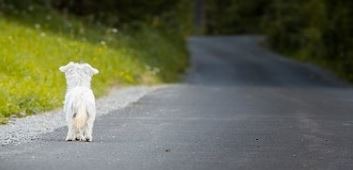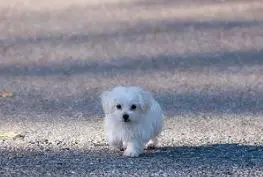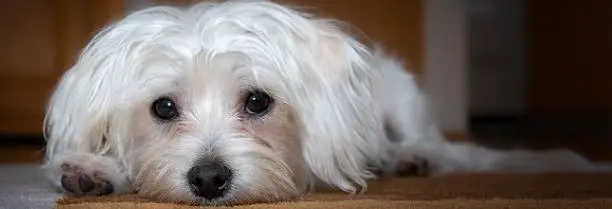How far should I walk a Maltese puppy?
Maltese are not the sort of dog you want to take hiking but they do love their walks.
The distance a Maltese can walk will be dependent on age, health, injuries and conditioning. Generally though a Maltese adult should walk at least once per day for 20 mins. A young Maltese puppy should only walk for short burst of 4-5 minutes until they work up the stamina. An older Maltese at 10 years or older should only be walking a casual pace for about 10 minutes or less.

GENERAL GUIDELINES FOR MALTESE EXERCISE
- Maltese Puppies
- Around 5 Minutes of walking per day at least twice a day at around 300 metres per walk.
- Maltese Adult
- Around 20 Minutes of walking once to twice a day at around 1.5 kilometers per walk.
- Maltese Elder
- Around 10 minutes of walking over a shorter distance at a slower pace around 500 meters per walk.
FACTORS AFFECTING THE WALKING DISTANCE OF A MALTESE
You will learn very quickly what your dog is capable of walking and when it does not want to walk anymore. Maltese will like to be carried if the walk becomes too long for them. If you are trying to plan out your walks with your cute furry friend then the main important factors to consider are:
- AGE : How old is your dog? Young puppies will have burst of energy but will tire out quickly considering the number of steps their little legs need to take to keep up with your giant strides. A adolescent Maltese and Adult Maltese will be able to go for a longer time frame than a puppy as they will be more conditioned and have slightly longer legs. As your Maltese ages into its twilight years it will still want exercise but it will run out of steam very quickly. As they get older you will need to shorten the walks as they will not have the physical condition to keep up and will tire quickly. You should keep the walks to less than 500 meters at this age.
- HEALTH : A dog which has heart or breathing issues will not be able to keep up but they will try and not show it. Dogs are pack animals and the weakest get left behind so it is ingrained in your dogs to try and hide any medical conditions when walking. Heart issues can restrict the flow of blood providing oxygen to the muscles and heavy exercise may put undue pressure on the poor little puppy. Breathing can be a problem for some Maltese especially those which have reverse sneezing. This is a condition affecting the amount of air which can be breathed in when they are excited. If you find your Maltese struggling to breath or panting excessively it would be a good idea to slow down, give them a break or even carry them for a while. Remember for one of your steps they are probably taking 10-20 steps.
- CONDITIONING : If you do not regularly exercise your Maltese then it may be out of shape and struggle on a walk. Just like humans can condition their body with exercise a dogs body will not be ready for a long walk if it sleeps all day. A lazy Maltese will obviously not be in the best condition compared to a very active dog which is constantly on alert and chasing everything in the backyard which moves. Knowing your dogs conditioning is very important in working out how far to take your Maltese for a walk.
- INJURIES : An injury to a Maltese will restrict how far it can walk. If your dog has injured itself then your vet should be consulted before any exercise is undertaken. Any exercise, especially a long walk or fast walk, could make the injury worse. Your vet should be able to supply you with the best advice on what rest is required and when walks can resume. Do not fear though as most Maltese will quickly recover from minor injuries and be ready for a walk as soon as they can. Maltese are notorious for having small dog syndrome and will want to prove they are fine and ready to tackle the biggest challenges thrown at them.

TIPS FOR WALKING A MALTESE DOG
Maltese are not dogs which will want to go on long walks so here are a few good rules and tips to help out while walking your Maltese.
- Maltese are small dogs and when they are younger you want to keep the walks shorter and let them build up the stamina and the bone and muscle structures in their legs to keep them going. While puppies are full of energy it is just bursts and they will tire quickly so keep it short.
- Use a dog walker or another family member to help walk your Maltese. People have busy lives and walking your dog isn’t always possible. Having a backup walker will help ensure your Maltese is fit and healthy by ensuring they get their exercise every single day.
- Remember to take into account the temperature when you are walking. Dogs have fur coats and should not be walked in the heat. Try and aim to walk early mornings and late evenings when it is cooler.
- Ensure you have a good collar that fits correctly. A poorly fitted collar can allow your dog to pull their head out and get away from you. It is a terrifying experience to have your dog loose on a road or if you lose them. So make sure you check the collar and make sure it is not too tight but not too loose around their neck. Another option is to get the full body collars which wrap around their neck and body and are basically impossible for them to get out of.
- Ensure your leash is in good condition. Just like the collar you need to ensure the leash is not frayed and likely to break. Check the clasp/clip to ensure that it is fully enclosed around the collar and will not come loose. When using the leash ensure it is loose so that there is no pull on the dog. A tight leash will lead to your Maltese pulling and this will be annoying to both you and your pet. Leave it loose as long as your Maltese walks beside you.
- Ensure your dog walks beside you in a controlled manner. Maltese are proud dogs and will try and lead the walk. Training them to walk beside you can be a frustrating experience and can appear to be futile but be rest assured that using positive reinforcement with treats will eventually getting them to walk beside you rather than in front of you. The main reason you want the dog beside you is that if it leads it will think it is in charge. This can lead to your Maltese being more aggressive and taking a protective mindset which will mean lots of unwanted attention from barking while you exercise.
- Bring a plastic bag. In most countries it is illegal not to clean up after your dog if they have left a mess in public. Even if it is not illegal in our country it is just common sense and good manners to clean up the mess your dog makes. A few plastic bags turned inside out make it nice and easy to pick up and dispose off in a sanitary way.
- Bring some water and, if possible, a small bowl. If you intend to walk for 20 mins or more with your little Maltese then expect that it will need a drink along the way. Ensure your dog is well hydrated during and after the walk. Remember they are wearing a fur coat and have short legs so they are doing a lot more exercise then you think and will be feeling he heat. A good idea is to ensure their water bowl at home is full before you go on your walk so your dog can have a drink as soon as it returns.
- Nutrition for your dog is very important. Having a healthy diet and healthy food for your Maltese will ensure it has the energy to walk longer distances. Just like in humans a healthy diet and a good exercise routine keeps the body healthy.

IDENTIFYING WHEN THE WALK IS TOO LONG FOR YOUR MALTESE PUPPY
When walking your dog you should pay close attention to your Maltese as the walk gets longer. Remember they only have short legs and what might seem like a short distance to you may be a very long distance to them. Keep an eye out for:
- EXCESSIVE PANTING – Panting associated with a tongue hanging out of your dogs mouth means its probably approaching its limit and you should stop for a water break and possibly carry your Maltese for the rest of the trip or at least long enough for it to rest. If your dog is panting check if they are drooling. If they are not drooling then they are likely dehydrated and you should get water into them as soon as possible. Dehydration can be dangerous and dogs need water on a constant basis. This is why it is always good to carry some water and a bowl for your Maltese.
- HEAVY BREATHING – If you can hear you dog breathing then your dog may need a break. Its a good idea to stop and take a rest. Your dogs breath should return to normal within a few minutes and if it doesn’t then you really shouldn’t continue walking anymore. You should carry your dog for the rest of the way and ensure it gets water and rest when you get home. Just keep an eye on it to ensure the breathing doe return to normal after it has had an extended rest.
- SLOW – If your Maltese is slowing down then you know its probably got to the end of its workout. A dog stopping and sniffing a post is not what I mean by slowing down. If your dog starts to lag behind you when walking then this is when it has had enough or your speed is just too quick for it. Slowing down is usually the first sign of the distance being too far and you should be nearing the end of your dog walk by the times these symptoms are being displayed.
- LIMPING – If your Maltese suddenly becomes lame and/or limping wile walking it may have strained something and injured itself. Stop the walk at this point and carry your dog back home. Give the dog some rest and if the limp persists you should go immediately to a vet. Keep in mind this is one sign of a tick and its worthwhile ensuring that no ticks have been picked up in the fur of your dog. The key areas are ears, underbelly and tail. Ticks are very dangerous to dogs and can be fatal.
- JUMPING UP – If your dog starts jumping up and wanting to be carried then they have had enough. They are saying to you that they do not want to walk anymore and want to be carried.
Every dog is different when it comes to walking and some dogs will push on with the walk even when they are exhausted. Get to know your dog over several walks and you will start to know their personality and when they are at their limit. If you keep on the lookout for over exertion then you and your dog should both have enjoyable walks.
MALTESE AND LONG WALKS AND HIKES
Maltese are not dogs to take on a hike unless you expect to carry them significant parts of the way. They will start out strong and be tired within the first 10 minutes of your hour long hike. If you really want to take them with you then buy a dog harness so you can strap them onto you and carry them easily.
WALKING AN OVERWEIGHT OR UNFIT MALTESE
Unfortunately unfit owners generally lead to unfit pooches so try and use your Maltese as an excuse to keep yourself fit at the same time. Maltese can become unfit and overweight if they are overfed and not exercised. Starting an exercise routine without easing in your Maltese can be dangerous and lead to walks which are uncomfortable for them. The best tips to walk an unfit or unhealthy Maltese include:
- Start Slow and only walk at a slow pace so your Maltese can keep up
- Use Short walks to build fitness and get into the flow of walking
- Carry them when needed. They may need some help to keep going.
- Rest often. If they need to rest then its best to give it to them and let them recover. You can resume your walk once everyone is back to a normal breathing state.
- Bring lots of water. Water will be the lifeline for an unfit dog as they will dehydrate quickly.
Getting your Maltese to do exercise will be very beneficial in that it will help regulate and control body weight, cardiovascular rhythm and lung capacity. This helps with all of the organs in the body including the lungs, kidneys and heart. It also delays the onset of any osteoarthritis and the mental stimulation of the walk with help keep their brain sharp and focused.
 height=”254″/>
height=”254″/>IF YOU DO NOT WALK YOUR MALTESE BAD THINGS CAN HAPPEN
If you don’t keep up a regular exercise routine with your Maltese and they tend to sleep every day then they are at risk of several issues:
- osteoarthritis
- Overweight
- Boredom
- Separation anxiety
- Poor blood flow
- Hypertension
Keep both yourself and your dog fit and it will ensure a safe, healthy and happy home.